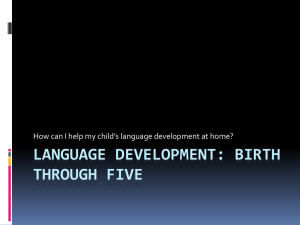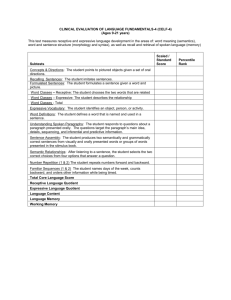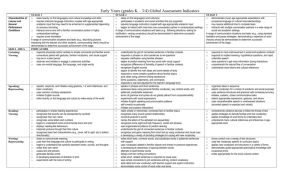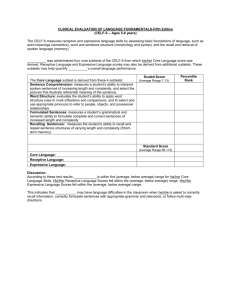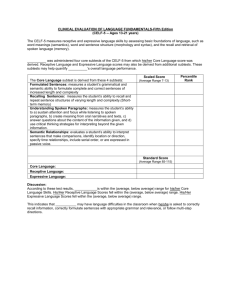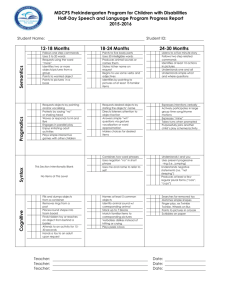Language Development
advertisement
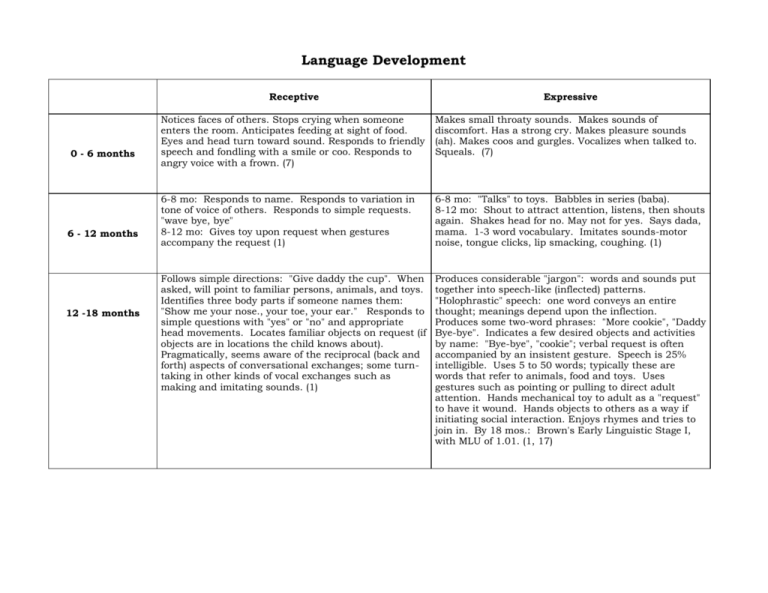
Language Development Receptive 0 - 6 months 6 - 12 months 12 -18 months Expressive Notices faces of others. Stops crying when someone enters the room. Anticipates feeding at sight of food. Eyes and head turn toward sound. Responds to friendly speech and fondling with a smile or coo. Responds to angry voice with a frown. (7) Makes small throaty sounds. Makes sounds of discomfort. Has a strong cry. Makes pleasure sounds (ah). Makes coos and gurgles. Vocalizes when talked to. Squeals. (7) 6-8 mo: Responds to name. Responds to variation in tone of voice of others. Responds to simple requests. "wave bye, bye" 8-12 mo: Gives toy upon request when gestures accompany the request (1) 6-8 mo: "Talks" to toys. Babbles in series (baba). 8-12 mo: Shout to attract attention, listens, then shouts again. Shakes head for no. May not for yes. Says dada, mama. 1-3 word vocabulary. Imitates sounds-motor noise, tongue clicks, lip smacking, coughing. (1) Follows simple directions: "Give daddy the cup". When asked, will point to familiar persons, animals, and toys. Identifies three body parts if someone names them: "Show me your nose., your toe, your ear." Responds to simple questions with "yes" or "no" and appropriate head movements. Locates familiar objects on request (if objects are in locations the child knows about). Pragmatically, seems aware of the reciprocal (back and forth) aspects of conversational exchanges; some turntaking in other kinds of vocal exchanges such as making and imitating sounds. (1) Produces considerable "jargon": words and sounds put together into speech-like (inflected) patterns. "Holophrastic" speech: one word conveys an entire thought; meanings depend upon the inflection. Produces some two-word phrases: "More cookie", "Daddy Bye-bye". Indicates a few desired objects and activities by name: "Bye-bye", "cookie"; verbal request is often accompanied by an insistent gesture. Speech is 25% intelligible. Uses 5 to 50 words; typically these are words that refer to animals, food and toys. Uses gestures such as pointing or pulling to direct adult attention. Hands mechanical toy to adult as a "request" to have it wound. Hands objects to others as a way if initiating social interaction. Enjoys rhymes and tries to join in. By 18 mos.: Brown's Early Linguistic Stage I, with MLU of 1.01. (1, 17) Looks at pictures in books, follows simple commands "put it on the table." Points and names 2 to 3 familiar pictures or objects. 18 - 24 months Receptive 24 - 30 months 30 - 36 months Uses jargon and phrases, has 10 - 50 words in vocabulary. Speech intelligibility is 25%, deletion of unstressed syllables by age 18 mos. At 24 mos. they are 60% intelligible and all vowels are learned except for the vocalic /r/. During this stage the front consonants continue to develop. Expressive The two year old can identify five pictures or more of common objects. This child can follow simple single step directions (9). Excellent comprehension in comparison to expression (2). This is mainly a period of transition for the child. Jargon is discarded, objects and pictures are named, pronouns are beginning to be used. By two and a half, the child can give his full name, identify seven common objects and give use of some objects (9). This child can identify themselves as either a boy or a girl (2). This period begins with approximately 200 words and this vocabulary grows rapidly. 2-3 word sentences are used along with "NO" and "MINE". The two year old loves to chant and sing songs. Numbers and the alphabet may be repeated but the concepts behind the symbols are not realized (18). The two year old learns new words almost every day, but there are many mistakes in grammar (21). The two and a half to three-year-old can understand most common adjectives and verbs, point to 6 body parts on a picture of a doll, sorts colors and points to several colors when named, understand comparatives like longer and bigger. (8) Thirty to thirty-three month-old children use most basic grammatical structures, over regulate plurals and verbs (foots and goed), vocalize all their needs, give full names on request, participate in storytelling, recite a few nursery rhymes, and use 200 or more words. Thirty-four to thirty-six month old children verbalize two prepositions, begin to respond to opposite analogies, repeat five word sentences, use short sentence when relating experiences, ask questions beginning with "what," "where," "when," use intelligible words about eighty percent of the time, use 300 to 100 words, and verbalize three prepositions. (8) 36 - 42 months 42 - 48 months 48 - 54 months 54 - 60 months Responds to commands involving 2 actions or objects and responds appropriately to simple "how" questions ("How are you?"). Understands "cold", "hungry", and "tired", as well as prepositions. Recognizes colors. Understands all possible sentence forms found in adult speech. (21) Vocabulary: 250 to 1000 words, with approximately 80% intelligibility. Grammar close to informal adult speech. Produces 3 to 4 word sentences. Seeks ways to clarify and correct misunderstandings and increasingly uses language as an instrument of control. Uses regular plurals and begins to use irregular plurals; uses pronouns; makes opposite analogies; asks questions using "who" and "what"; can supply the last word of simple sentences; points to and counts 3 objects; begins to use "is" at the beginning of simple sentences; begins to use contractions and third person present tense; uses "is", "are", and "am" in sentences. Identifies a circle and square, and hard, soft, and rough objects. (21) Receptive Expressive Repeats one series of three digits correctly. Answers two comprehensive questions. Names all pictures correctly. ' Carries out three prepositional commands. Understands spatial concepts. Understands concepts of color, shape, and size. (10) Use of language as an instrument of control increases.(21) Mean length of utterance is six words. (24) Names pictures and tells the action. (10) Gives full name and tells sex. (10) Speaks in well-formed simple sentences. (10) Uses plurals. (10) Refers to himself by pronoun. (10) Answers "Whose?" "Who?" "Why?" and "How many?" Recognizes simple shapes: circle, square, triangle. Names pictures correctly Understands concepts of "tallest." "biggest," "same," and "more." Recognizes several printed words(Marotz) Uses the prepositions "on," "in," and "under" Uses possessives consistently: "hers," "theirs," "baby's" Uses "can't" to mark negatives. Begins to use past tense of verbs Recites and signs simple songs and rhymes Produces elaborate serene structures (Marotz) Comprehends 1500-2000 words. Understands dependent clause: if, because, when, why. Carries out more complex commands with 2-3 actions. Understands prepositions. (11) Child has a lot to say. Enjoy playing with words. (Miller) Vocabulary of approximately 2000 words. Mean sentence length is approximately 4 words. Will tell a story about himself or environment with slight stimulation. Uses conjunctions. (11) 60 - 66 months 6 years 72 - 84 months Five-year-olds understand three-order commands, obey correctly directions to wash his/her hands, bring a chair, and drink a cup of milk. Understand concepts of time such as today, yesterday, and tomorrow. Understands number concepts including plurals, know their colors, and locates requested objects in the real world accurately. Understands sentences with two adjectives, and knowledge of what is meant by: How much, how far, and when. (20) Fairly complex sentences are produced, embedding two ideas with a single sentence. Has added reflexive pronouns. He/she asks questions beginning "How" and "why" and "which." Syntax/morphological = produces short passives (lost, left, broken). Pragmatics = uses mostly direct requests, repeats for repair, begins to use gender topics. Nearly adult-like. (20) Has receptive vocabulary of 20,000 - 24,000 words, which he defines by function; Comprehends parallel embedding, imperative commands, -man suffix (-er by 6.5); Identifies syllables; Acquires rule for plural (/s/, /z/, /Iz/)(19). Has expressive vocabulary of 2,600 words, which he defines by function; Uses many with plural nouns; Responds to indirect hints; Repeats with elaboration for repair; Uses adverbial conjuncts now, then, so, though (19). Names most letters and numbers; Counts by rote to 10; Uses all grammatical structures: pronouns, plurals, verb tenses, conjunctions; Uses complex sentences: carries on conversation (1). Receptive 8 years 10 years Expressive Comprehends 'because' and spatial, temporal, familial, disjunctive, and logical relationships. Literally interprets proverbs. Aware of metalinguistics and can concentrate on and process two aspects of language simultaneously, message meaning and linguistic correctness (19). Uses full passives, sustains concrete topics, and begins to consider other's attention (19). Good comprehension, 40,000 words; Comprehends "in" and "on" used for temporal relationships; Comprehends most familial terms; Comprehends and uses "asks"; acquires multiple meanings (21) Spends a lot of time talking; Writing becomes more mature than speech; Role-play occurs (21)

